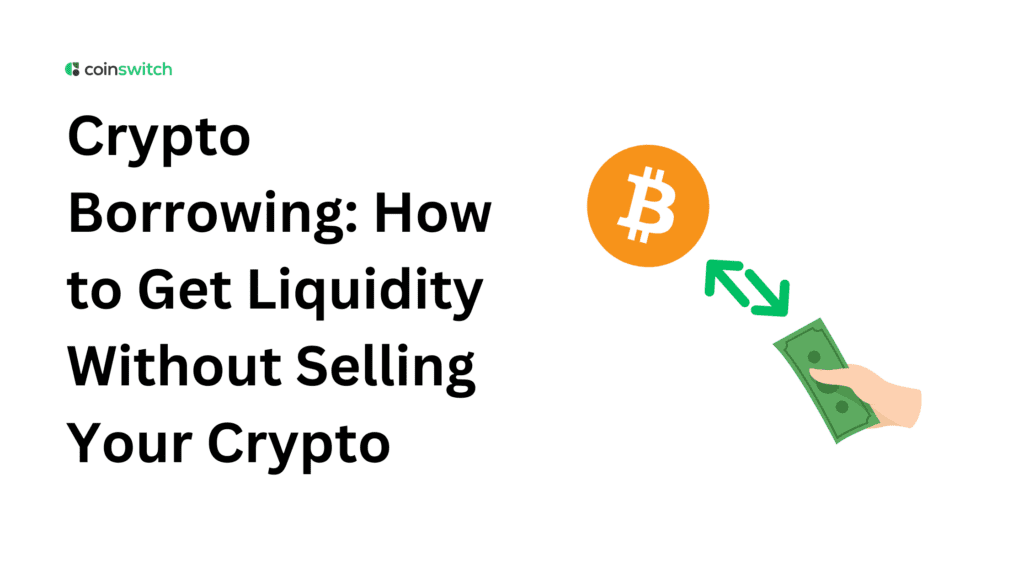You’ve built a strong crypto portfolio. Bitcoin’s shining in your wallet, Ethereum’s growing by the day, and life feels good, until something unexpected pops up. A big payment. A dream opportunity. Maybe an emergency.
You don’t want to sell your coins as you’ve seen what happens after every dip: prices rebound, and you regret selling too soon. So how do you unlock cash without parting with your assets? That’s where crypto borrowing steps in. It’s the digital version of a gold loan, except your crypto is the gold. Many crypto platforms let you take a crypto pur loan, explore crypto loans without collateral, or even get a Bitcoin loan in minutes. You stay invested, you get liquidity, and your crypto keeps compounding quietly in the background.
What Is Crypto Borrowing?
Crypto borrowing is a modern twist on an old idea, using something valuable as collateral. In this case, your digital coins take the place of real-world assets. You lock your crypto on a lending platform, and in return, you receive stablecoins or fiat currency. Once you repay, your crypto is released.
What makes this model special is how seamless it feels. There’s no credit score check, no branch visit, and no long form to fill out. The blockchain handles it all. Your holdings become your reputation. If you own ₹10 lakh worth of Bitcoin, you can borrow around ₹5 lakh instantly, depending on the loan-to-value ratio (LTV) set by the platform.
For many investors, it’s a win-win. Their coins remain in the market, riding any future price rallies, while the borrowed cash covers real-world needs. It’s why crypto borrowing now sits comfortably beside staking, trading, and yield farming as one of the most popular tools in the digital wealth space.
How Does Crypto Borrowing Work?
Think of it as a secured loan powered by smart contracts. You deposit your Bitcoin, Ether, or stablecoins into a lending protocol like Aave, Nexo, or Binance Loans. The platform automatically evaluates the value of your holdings and disburses a loan, often within minutes.
If you take a Bitcoin loan, your BTC gets locked in a secure smart contract. You receive stablecoins such as USDT or USDC, or even rupee-pegged currency in some regions. Repay the principal and interest, and your Bitcoin returns safely to your wallet.
The best part? It’s transparent. The blockchain doesn’t bend rules or lose paperwork. Everything happens in real time. But there’s a catch: the market keeps moving. If the price of your crypto falls below the liquidation threshold, the system automatically sells part of your collateral to maintain balance. That’s the trade-off for instant liquidity.
Meanwhile, the DeFi world is pushing innovation further. Newer projects experiment with crypto loans without collateral, where users with strong on-chain histories can borrow based on reputation instead of deposits. It’s early, but the direction is clear: DeFi wants to make borrowing feel like a conversation, not a contract.
Read More: How to Create a Crypto: The Simplest Guide
Advantages of Crypto Borrowing
The charm of crypto borrowing lies in freedom. You get access to cash without losing exposure to the crypto market. That’s huge for anyone who believes in crypto’s long-term prospects.
There’s also flexibility. Traditional lenders see your credit score; crypto lenders see your wallet. If your holdings are strong, you qualify, simple as that.
Interest rates can be surprisingly attractive. Stablecoin loans often carry single-digit annual rates, much lower than personal loans or credit card balances. And because repayment terms are adjustable, you can pay early or extend if the market is volatile.
Some investors even use borrowed liquidity to reinvest. They park funds in staking pools or DeFi platforms that generate a yield higher than the loan’s interest rate. Done smartly, that strategy compounds profits while keeping original holdings untouched.
And here’s the bonus: borrowing doesn’t trigger capital gains tax since you’re not selling your crypto. You keep the asset, the upside, and the control.
Risks and Considerations in Crypto Borrowing
But let’s keep it real, crypto borrowing isn’t a free ride. The market’s volatility cuts both ways. If Bitcoin’s price tanks 20% overnight, your collateral ratio shifts dangerously close to liquidation. The system might sell part of your holdings before you can react. That’s not a pleasant surprise.
Platform security is another big factor. Centralized services like Nexo or YouHodler do not directly manage asset custody, but rely on third-party custodians. They’re convenient, but you’re trusting them with your coins. Decentralized ones like Aave rely on code, no middlemen, but also no recovery if a smart contract fails.
Rates fluctuate, too. During bull runs, borrowing costs spike because demand surges. In quieter markets, you’ll find cheaper liquidity. Timing matters more than most realize.
The golden rule? Borrow responsibly. Don’t stretch beyond what you can comfortably repay, even if the market turns rough. The same innovation that enables fast loans can amplify losses if used carelessly.
Read More: What is NFT lending?
The Future of Crypto Borrowing
The concept has outgrown its experimental phase. What started as a niche service in the DeFi corners is now spreading across mainstream exchanges and fintech platforms. From Coinbase to Binance, everyone’s offering borrowing features.
The next wave looks even more interesting. Expect multi-asset collateral, using NFTs, staking rewards, or tokenized stocks to secure loans. Soon, platforms offering crypto pur loan and Bitcoin loan options will function like full-fledged digital banks.
AI and on-chain analytics will personalize the experience further. Wallets with consistent repayment history may receive better rates, mimicking credit scoring but without paperwork. That evolution could unlock true crypto loans without collateral, where trust is data-driven, not manually assessed.
Regulations will mature too. Countries are slowly defining how crypto lending fits into financial law. Once the framework stabilizes, traditional banks might join the ecosystem, bridging fiat and DeFi more smoothly.
At its core, crypto borrowing reflects where finance is headed: instant, borderless, and data-driven. It’s no longer a backup plan; it’s becoming a preferred tool for managing wealth dynamically.
Conclusion
Crypto borrowing isn’t about escaping traditional banking; it’s about rewriting its rules. It gives digital asset holders a way to stay liquid without surrendering their conviction. You keep your Bitcoin, use its value, and stay positioned for the next bull wave. That’s financial agility in its purest form.
Smart investors use these loans strategically. They watch market cycles, monitor LTV ratios, and choose credible platforms. For them, a Bitcoin loan isn’t a gamble; it’s a tactical move to keep capital productive.
The industry’s future looks strong. As liquidity deepens and platforms mature, borrowing will feel as routine as swiping a card. You’ll see businesses using crypto credit lines, individuals refinancing with stablecoins, and developers building apps that merge DeFi and daily life.
The takeaway is simple: crypto borrowing isn’t just an option; it’s a sign of how adaptable digital finance has become. The system rewards those who understand timing, risk, and opportunity. Use it wisely, and your crypto will serve you twice, once as an investment and once as a source of liquidity.
FAQs
1. What is crypto borrowing?
It’s the process of using your crypto assets as collateral to get instant liquidity. You deposit coins on a platform, receive stablecoins or fiat, and reclaim your crypto after repayment. It’s fast, digital, and doesn’t require a traditional credit profile.
2. How can I borrow money from crypto?
Choose a trusted platform, connect your wallet, deposit your assets, and set your loan amount. Once approved, the funds land in your account instantly. Platforms like Aave, Nexo, and Binance Loans make it seamless.
3. How to take a loan against your crypto without selling it?
You can avail a loan against your crypto without selling it. Essentially, you pledge your crypto holdings as collateral with a crypto lending platform to receive a loan in fiat currency like USD or stablecoins like USDT.








